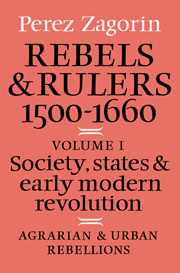7 - Agrarian rebellion
Published online by Cambridge University Press: 12 January 2010
Summary
In this and the following chapters, we pass from the general and contextual considerations of the first two parts of our study to a discussion of the different types and selected cases of early modern revolution. Our aim in this present part is to bring out the distinctive forms and variety of revolutions in the sixteenth and earlier seventeenth centuries and to illuminate by means of some particular examples the range and permutations of revolutionary action that the early modern world engendered.
We begin with agrarian rebellion, the most profound, the fiercest expression of defiance and resistance by the common folk of this society.
Here we enounter, first of all, the peasant. But, like his medieval forebears how rarely did he speak for himself, how difficult it is to know his thoughts and feelings! Although revolt may occasionally throw a strong light on his mind and griefs, he remains obscure, a part of the great inarticulate mass at the base of his society. Yet he is an inescapable figure, as elemental as the great tortoise of Indian mythology, which was said to uphold the world, for it was his obedience and toil that sustained the princes, nobilities, and landlords, his rulers and betters.
In the main we are compelled to see the peasant through eyes remote or different from his own, from the angle of the literate and those who did not share his life. Numerous images of him exist among the wealth of contemporary prints and paintings, most memorably of all, perhaps, in the art of the great Netherlander master, Pieter Brueghel, born around the time of the German peasant war.
- Type
- Chapter
- Information
- Rebels and Rulers, 1500–1600Society, States, and Early Modern Revolution, pp. 175 - 227Publisher: Cambridge University PressPrint publication year: 1982

